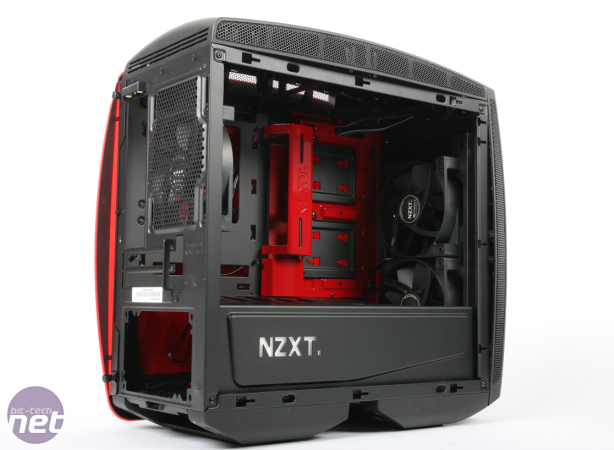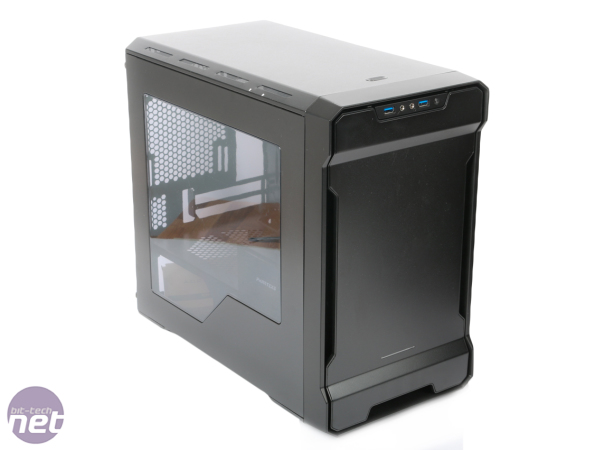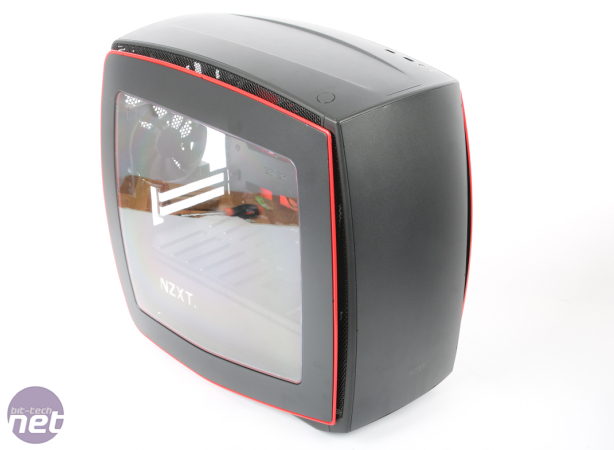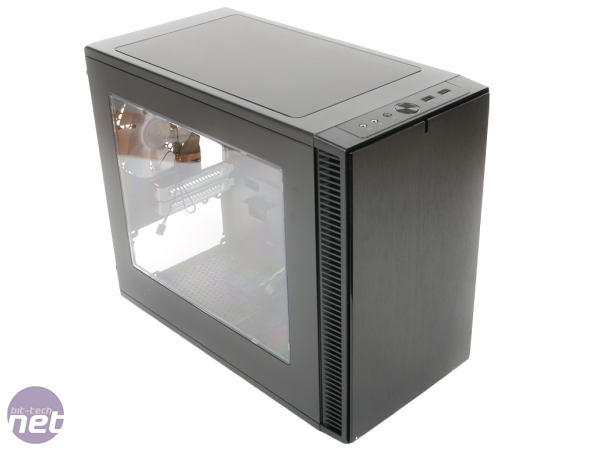Fractal Design vs NZXT vs Phanteks: What's the best new mini-ITX tower case?
March 29, 2016 | 15:19
Companies: #bitfenix #bit-tech-tech #fractal-design #nzxt #phanteks

Build quality and aesthetics: Winner - NZXT Manta

Neither the Nano S or Evolv ITX struck me as being stellar in this area, but it's undoubtedly one of the main reasons to consider the Manta. It feels solid, it looks robust and all the internal fixtures are well made and designed. In short, while it may not appear to be worth twice the asking price of both the other cases on paper, a hands-on experience may well change your mind.
The exterior is sleek and sweeping too, even if the curved, bulbous design may not be your thing and adds even more bulk to the already hefty dimensions. That's not to say Fractal Design's and Phanteks' offerings are poor - for the price they're exactly what you'd expect, but as we're directly comparing the three cases, price aside, the Manta wins hands down and helps to justify its tall asking price.
In terms of looks, the Manta can also look great in some of the colour options. The black sample we reviewed appears a little bland, but having seen a red/black combo too, it's seriously sexy. Again, in person there's something about this case that I can't quite put my finger on. Even looking at the review now it looks a tad uninspiring. However, sat on a desk in front of you, I defy anyone to not want to build a flashy water-cooled rig into one.
Fractal Design's cheaper cases aren't known for their good looks and the Nano S is no exception. The Evolv ITX is definitely racier, while the Manta is more elegant and unique. I'd say Fractal Design has focused on making the Nano S a functional case and they've hit the nail on the head, although Phanteks has done a fantastic job here considering the Evolv ITX costs significantly less than Fractal's offering too.
Reasons to consider:
The Phanteks Enthoo Evolv ITX

Despite its shortcomings, I do still like the Phanteks - I housed my own system in one with a new paint job and rigid metal tubing for over a year. It looks good, has reasonable water cooling support and a solid set of features plus it's the cheapest case of the trio by a long way. However, it doesn't really offer any advantages other than price.
The NZXT Manta

If money or size aren't much of a concern but you're dead-set on a mini-ITX rig, then the Manta is for you. It scores very highly on build quality, aesthetics and all-round water-cooling support and doesn't have many significant compromises. It beats the Evolv ITX in pretty much every area except for size and price, but I'm a tad disappointed by the external design - NZXT could have done things slightly different hear and the internal features can be a bit haphazard too, compared to the simpler, cheaper Nano S.
The Fractal Design Define Nano S

This is the case that made me think about writing this article. It's essentially the mini-ITX case we've been waiting for and amazingly, despite several attempts from various manufacturers, Fractal Design included, the dimensions and features on offer here are almost spot on. It's small enough that, when its features and water-cooling credentials are considered, it can't moonlight as a micro-ATX case. Vertically it's just tall enough to house an ATX PSU, dual-slot graphics card, mini-ITX motherboard and a radiator with fans - that's it.
If you argue you could fit a micro-ATX board in there you're wrong - you'd have to make the case bigger, as you would a similar-sized micro-ATX case that lacked similar water-cooling support. That wasn't the situation with the Prodigy, which as we all know, was easily modded to fit microATX motherboards. Length-ways there's space for the motherboard, cable routeing holes, reservoir and a big ol' radiator. Admittedly, I'd maybe have lopped a few centimetres off the length, though - it's the only dimension the Evolv ITX is smaller and length is arguably the most important measurement when you're concerned about desk footprints.
My winner: Fractal Design Nano S
A lot of the mini-ITX offerings out there from Corsair, NZXT and others, appear to focus on the exterior first, or at the very least, bulk up the exterior too much in an attempt to make them unique. Mini-ITX cases ARE meant to be small, but having toyed with them for 15 years or so, I'm well aware of just how awkward anything smaller than the Nano S can be to work with if you're building a high-end system, especially if something breaks and needs to be identified and replaced and this is compounded when you add water-cooling into the equation.
The Nano S is big enough to make building and maintaining a high-end water-cooled system easy - much more so than most of the cube-style cases out there - yes they're small, but very often getting at the motherboard or removing a component that's plumbed into a water-cooling system is a nightmare. The Nano S is still smaller than pretty much any other tower mini-ITX case out there too, yet it manages to be one of the best for water-cooling as well.

The exterior is sleek and sweeping too, even if the curved, bulbous design may not be your thing and adds even more bulk to the already hefty dimensions. That's not to say Fractal Design's and Phanteks' offerings are poor - for the price they're exactly what you'd expect, but as we're directly comparing the three cases, price aside, the Manta wins hands down and helps to justify its tall asking price.
In terms of looks, the Manta can also look great in some of the colour options. The black sample we reviewed appears a little bland, but having seen a red/black combo too, it's seriously sexy. Again, in person there's something about this case that I can't quite put my finger on. Even looking at the review now it looks a tad uninspiring. However, sat on a desk in front of you, I defy anyone to not want to build a flashy water-cooled rig into one.
Fractal Design's cheaper cases aren't known for their good looks and the Nano S is no exception. The Evolv ITX is definitely racier, while the Manta is more elegant and unique. I'd say Fractal Design has focused on making the Nano S a functional case and they've hit the nail on the head, although Phanteks has done a fantastic job here considering the Evolv ITX costs significantly less than Fractal's offering too.
Reasons to consider:
The Phanteks Enthoo Evolv ITX

The NZXT Manta

If money or size aren't much of a concern but you're dead-set on a mini-ITX rig, then the Manta is for you. It scores very highly on build quality, aesthetics and all-round water-cooling support and doesn't have many significant compromises. It beats the Evolv ITX in pretty much every area except for size and price, but I'm a tad disappointed by the external design - NZXT could have done things slightly different hear and the internal features can be a bit haphazard too, compared to the simpler, cheaper Nano S.
The Fractal Design Define Nano S

This is the case that made me think about writing this article. It's essentially the mini-ITX case we've been waiting for and amazingly, despite several attempts from various manufacturers, Fractal Design included, the dimensions and features on offer here are almost spot on. It's small enough that, when its features and water-cooling credentials are considered, it can't moonlight as a micro-ATX case. Vertically it's just tall enough to house an ATX PSU, dual-slot graphics card, mini-ITX motherboard and a radiator with fans - that's it.
If you argue you could fit a micro-ATX board in there you're wrong - you'd have to make the case bigger, as you would a similar-sized micro-ATX case that lacked similar water-cooling support. That wasn't the situation with the Prodigy, which as we all know, was easily modded to fit microATX motherboards. Length-ways there's space for the motherboard, cable routeing holes, reservoir and a big ol' radiator. Admittedly, I'd maybe have lopped a few centimetres off the length, though - it's the only dimension the Evolv ITX is smaller and length is arguably the most important measurement when you're concerned about desk footprints.
My winner: Fractal Design Nano S
A lot of the mini-ITX offerings out there from Corsair, NZXT and others, appear to focus on the exterior first, or at the very least, bulk up the exterior too much in an attempt to make them unique. Mini-ITX cases ARE meant to be small, but having toyed with them for 15 years or so, I'm well aware of just how awkward anything smaller than the Nano S can be to work with if you're building a high-end system, especially if something breaks and needs to be identified and replaced and this is compounded when you add water-cooling into the equation.
The Nano S is big enough to make building and maintaining a high-end water-cooled system easy - much more so than most of the cube-style cases out there - yes they're small, but very often getting at the motherboard or removing a component that's plumbed into a water-cooling system is a nightmare. The Nano S is still smaller than pretty much any other tower mini-ITX case out there too, yet it manages to be one of the best for water-cooling as well.

MSI MPG Velox 100R Chassis Review
October 14 2021 | 15:04








Want to comment? Please log in.